![]()
![]()
![]()
Use LEFT and RIGHT arrow keys to navigate between flashcards;
Use UP and DOWN arrow keys to flip the card;
H to show hint;
A reads text to speech;
50 Cards in this Set
- Front
- Back

|
-Sacrifice of Isaac competition panels for the east doors of the Baptistery of San Giovanni -left Filippo Brunellschi, right Lorenzo Ghiberti -Florence, Italy -Early Renaissance -Ghiberti wins his panel was considered more graceful and smooth, Brunellschi is so insulted he abandons sculpting and takes to architecture instead |
|
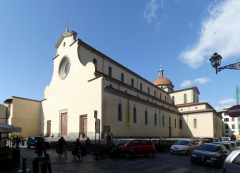
|
-exterior of the Santo Spirito -Filippo Brunellschi -Florence, Italy -Early Renaissance -Brunellschi died before it was finished, |
|
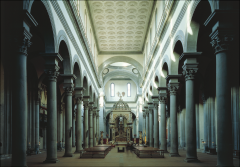
|
-interior of the Santo Spirito -Filippo Brunellschi -Florence, Italy -Early Renaissance -Brunellschi died before it was finished |
|
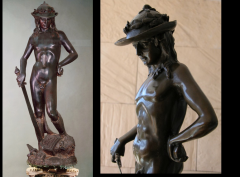
|
-David -Donatello -Florence, Italy -Early Renaissance -first nude since ancient times, displays contrapposto stance and idealized proportions |
|
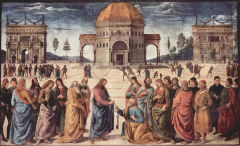
|
-Christ delivering the Keys of the Kingdom to St. Peter -Perugino -Sistine Chapel, Vatican City, Rome -Early Renaissance -establishes infallibility of the papacy, displays vanishing point, horizon line, and linear perspective |
|
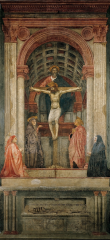
|
-Holy Trinity, Santa Maria Novella -Massacio -Florence, Italy -Early Renaissance -mathematically designed with vanishing point @ the foot of the cross |
|
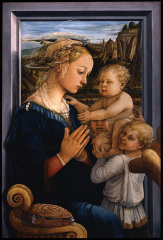
|
-Madonna and Child with Angels -Fra Filippo Lippi -Florence, Italy -Early Renaissance -shows humanistic side of Christ |
|
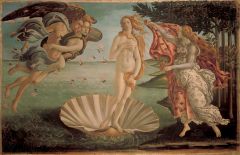
|
-Birth of Venus -Sandro Botticelli -Florence, Italy -Early Renaissance -uses physical beauty to inspire understanding of spiritual beauty |
|
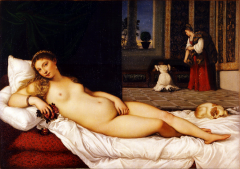
|
-Venus of Urbino -Titian -Ufizzi Gallery, Florence, Italy -Venetian High Renaissance -commissioned by Duke of Urbino for his wife, bold colors emphasize the nude woman |
|
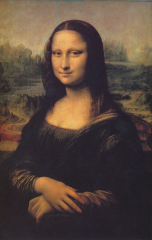
|
-Mona Lisa -Leonardo da Vinci -Louvre, Paris -High Renaissance -wife of wealth Florentine, no status symbols depicted, displays da Vinci's sfumato (misty haziness) |
|
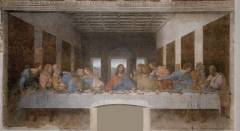
|
-The Last Supper, refectory, Santa Maria delle Grazie -Leonardo da Vinci -Milan, Italy -High Renaissance -da Vinci used a secco (painting on dry plaster w/ water based paint), Eucharist given for 1st time, |
|
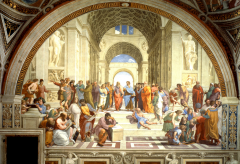
|
-Philosophy (School of Athens), Stanza della Segnatura, -Raphael -Vatican Palace, Rome -High Renaissance -commissioned by Pope Julius II (warrior-pope), connects papacy back to Roman Empire |
|
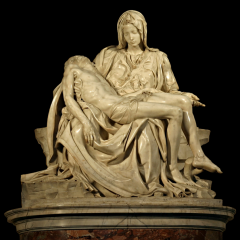
|
-Pieta, St. Peter's -Michelangelo -Vatican City, Rome -High Renaissance -emphasizes importance of Mary, downplays brutality of Jesus's crucifixion |
|
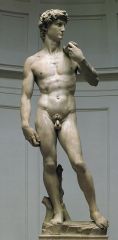
|
-David (Il Gigante), from Piazza della Signoria -Michelangelo -Florence, Italy -High Renaissance -portrayed before his battle with Goliath, idealized proportions |
|
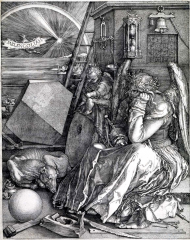
|
-Melencola I, engraving -Albrecht Durer -Victoria and Albert Museum, London -depiction of 4 humors fluids considered by Greek physician Hippocrates to be the basis of the body's functions: sanguine (blood), choleric (yellow bile), phlegmatic (phlegm), and melancholic (black bile), also based on work of Cornelius Agrippa's melancolia imaginitiva |
|
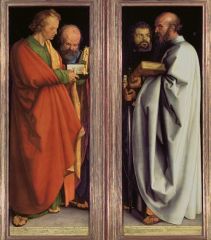
|
-Four Apostles -Albrecht Durer -in a museum in Munich -Protestant/Northern Renaissance -John/Peter on left Mark/Paul on the right, shows artist's support for Martin Luther b/c Peter is behind John |
|
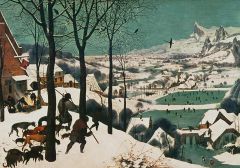
|
-Hunters in the Snow (December-January) -Pieter Brugel the Elder -Protestant/Northern Renaissance -landscapes portrayed smoothly |
|
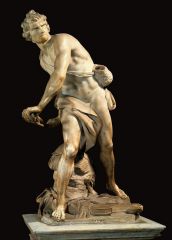
|
-David -Gianlorenzo Bernini -Rome, Italy -Baroque -shows battle, suggests movement |
|
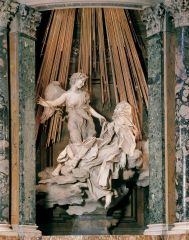
|
-Ecstasy of St. Teresa, Cornaro Chapel, Santa Maria della Vittoria -Gianlorenzo Bernini -Rome, Italy -Baroque -shows feeling of being stabbed (sexual implications), in a pediment |
|
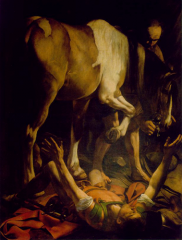
|
-Conversion of St. Paul, Cercasi Chapel, Santa Maria del Popolo -Caravaggio -Rome, Italy -Baroque -contrast between light and dark provokes emotional response |
|
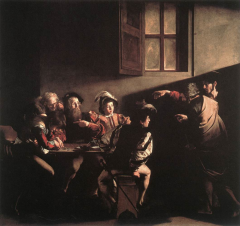
|
-Calling of St. Matthew, Contarelli Chapel, San Luigi dei Francesi -Caravaggio -Rome, Italy -shows Jesus's role as 2nd Adam |
|
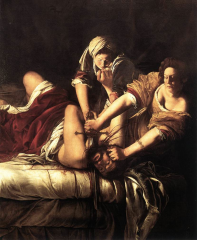
|
-Judith Slaying Holofernes -Artemesia Gentileschi -Florence, Italy -Baroque |
|
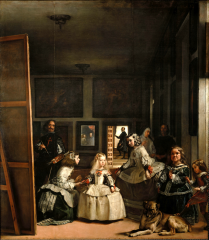
|
-Las Meninas (The Maids of Honor) -Diego Velazquez -Madrid, Spain -Baroque -scholars aren't sure what Velazquez is supposed to be painting in the painting |
|
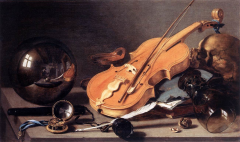
|
-Vanitas Still Life -Pieter Claesz -Dutch Republic -Baroque -vanity painting with a reminder of death |
|
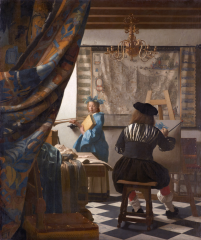
|
-Allegory of the Art of Painting -Jan Vermeer -Dutch Republic -Baroque |
|

|
-Archers of St. Hadrian -Franls Hals -Haarlem, Dutch Republic -Baroque |
|
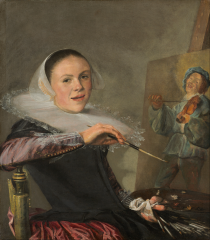
|
-Self-Portrait -Judith Leyster -Dutch Republic -Baroque -shows identity of artist (high class but still talented) |
|
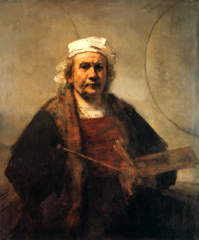
|
-Self-Portrait w/ 2 Circles -Rembrandt van Rijn -Dutch Republic -Baroque -shows his ability to freehand draw perfect circles |
|
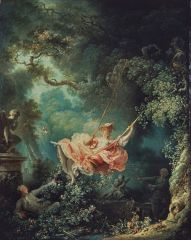
|
-The Swing -Jean-Honore Fragonard -France -Rococo -displays delicate, ornate, playful, sensual, aspects of Rococo style |
|

|
-A Philosopher giving a Lesson at the Orrery -Joseph Wright of Derby -Enlightenment Era -shows new knowledge about science |
|

|
-Cornelia Presenting her Children as Her Treasures/Mother of the Gracchi -Angelica Kauffman -Neoclassical |
|
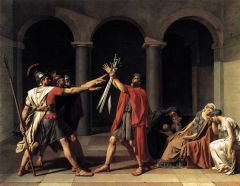
|
-Oath of the Horatti -Jacques-Louis David -France -Neoclassical -shows traditional views of men (courageous, loyal) and women (emotional) |
|
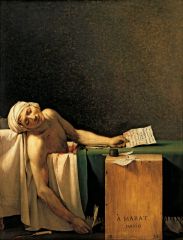
|
-Death of Marat -Jacques-Louis David -France -Neoclassical -meant to inspire revolutionary forces by showing Marat as a martyr |
|

|
-The Sleep of Reason Produces Monsters/The Dream of Reason Produces Monsters, from Los Caprichos no. 43 -Francisco Goya -Spain -Romanticism -shows romanticism's emphasis on creative process over staunch reason |
|
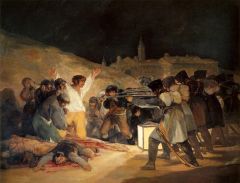
|
-The 3rd of May -Francisco Goya -Spain -Romanticism -shows empathy for Spanish peasants who were executed for no real reason |
|
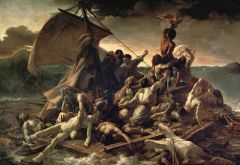
|
-Raft of the Medusa -Theodore Gericault -France -Romanticism -commentary of immorality of slavery |
|
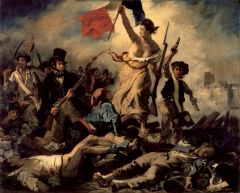
|
-Liberty Leading the People -Eugene Delacroix -France -Romanticism -inspiration for French revolutionaries |
|
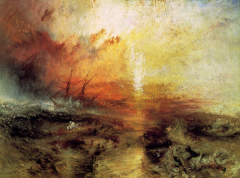
|
-The Slave Ship (Slavers Throwing Overboard the Dead and Dying, Typhoon coming on) -Joseph Mallord William Turner -England -Romanticism -antislavery work |
|
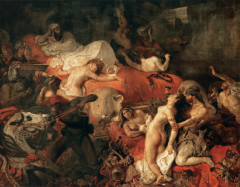
|
-The Death of Sardanapalus -Eugene Delacroix -France -Romanticism |
|
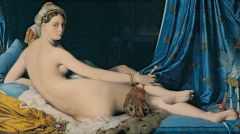
|
-Grand Odalisuqe -Jean Auguste Dominique Ingres -France -Romanticism -shows respect for Raphael |
|
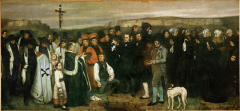
|
-Burial at Ornans -Gustave Courbet -France -Realism -shows mundane nature of life and death |
|
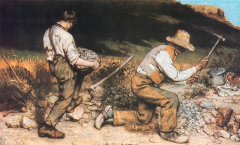
|
-The Stone Breakers -Gustave Courbet -France -Realism -shows how poverty is perpetuated in society |
|
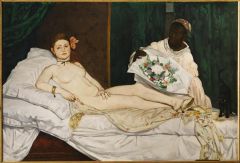
|
-Olympia -Edouard Manet -France -Realism -shows sexual independence of women, based on Venus of Urbino |
|

|
-War Side of the Standard of Ur, tomb 779 Royal Cemetary -Ur (Modern Tel Muqayyar), Iraq -Sumerian -shows need for military to sustain empires |
|
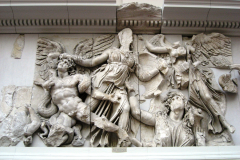
|
-Athena battling Alkyoneos, detail of the gigantomachy frieze of the Altar of Zeus -Pergamon, Turkey -Hellenistic -celebrates great Greek victory |
|
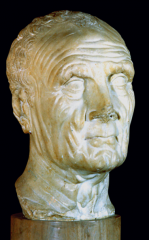
|
-Head of an Old Man -Osimo, Italy -Roman Republic -shows technique of verism |
|

|
-Portrait of the 4 Tetrarchs -Constantinople (Istanbul), Turkey -Late Roman Empire |
|
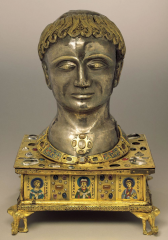
|
-Head Reliquary of St. Alexander, from the abbey church -Stavelot, Belgium -Romanesque -shows reverence people had for saint's relics easy way to get salvation |
|
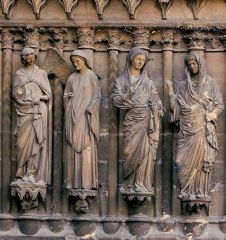
|
-Annunciation and Visitation, jamb statues from the central doorway of the west facade, Reims Cathedral -Reims, France -High Gothic |
|
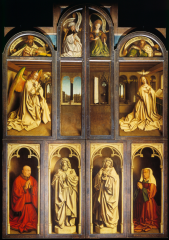
|
-Ghent Altarpiece, Saint Bavo Cathedral -Hubert and Jan van Eyck -Ghent, Belgium -Northern Renaissance |

